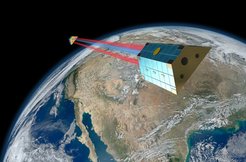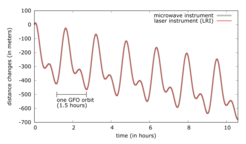New laser instrument onboard GRACE-Follow-On measures Earth's gravity field with high precision
One year in operation: the first laser interferometer between two satellites exceeds all expectations and is a successful step towards the space-based gravitational-wave observatory LISA
Since the end of May 2018, the two GRACE Follow-On satellites have been orbiting the Earth and measuring its gravitational field by monitoring the distance between them. This enables them to observe regional groundwater levels and global indicators of climate change. In addition to established technology, a new type of laser instrument (Laser Ranging Interferometer) has been in use for the first time since mid-June 2018. It measures 200 times more precisely and records changes in the distance of 220 kilometers with atom-diameter precision. An international research team, including researchers from the Max Planck Institute for Gravitational Physics (Albert Einstein Institute / AEI) and Leibniz University in Hanover, has now published initial results on the commissioning and performance of the laser instrument in Earth orbit. These exceed all expectations and show that the instrument works perfectly.
After the first major success – the successful “first light” of the Laser Ranging Interferometer (LRI) in June 2018 – the instrument worked perfectly apart from interruptions due to mission operations. Continuous measurements of more than 1000 orbits around the Earth show the instrument's reliability. Fast reacting control mirrors ensure that the laser connection between the satellites is not interrupted while the satellites are slightly jittering in their orbits. The international team used the data obtained to understand and evaluate the performance of the LRI in Earth orbit. The results are impressive:
More precise technology for future satellite missions

“The Laser Ranging Interferometer on board GRACE Follow-On works perfectly – it's a dream! The instrument measures distance changes between the satellites very precisely, about 200 times more precisely than the established microwave technology and thus 20 times more precisely than specified in the mission requirement,” says Prof. Gerhard Heinzel, head of the Space Interferometry group at AEI and manager of the German contributions to the LRI. “This will not only make future Earth observation satellite missions even more accurate, but will also pave the way for gravitational-wave observation in space with LISA”. The international team of researchers has now published the results in the journal Physical Review Letters.
“The laser beam from one satellite has to point at the other exactly in order for our distance measurement to be so precise,” Heinzel explains. “Initially, the laser is aligned so well that it would hit a plate at a distance of 100 meters. For a successful laser connection, we then have to point it at a two-Euro coin on this plate. When the automatic targeting mechanism has done this by means of the control mirrors, it always targets a point in the inner half of the coin with the highest accuracy. We then always hit Mallorca on the two-Euro coin at a distance of 100 meters, while the satellites’ jitter moves the coin around three centimeters!

GRACE Follow-On continues the successful observations of the GRACE mission (2002-2017) since mid-2018 using the established microwave distance measurement of the previous mission. The LRI is a demonstrator that tests technology for future missions, but at the same time delivers measurement data of the highest accuracy. The LRI determines the changes in distance between the satellites to within fractions of a nanometer, which is roughly equivalent to an atomic diameter.
Solving the mystery of laser data jumps
“A surprise in the LRI measurement data were sudden jumps in the laser measurements – a mystery that we have solved with our analysis over the past few months,” explains Dr. Vitali Müller, a researcher in the Space Interferometry group at AEI. “If the satellites activate their thrusters for attitude control several times per Earth orbit, the jumps are easily detected and corrected in the measured data. These jumps do not affect the performance of the LRI.”
Weighing the ice on Earth from space
“Only satellite observations from space can track on the entire Earth how ice masses, groundwater levels, and other indicators of the Earth system that are important for the future of mankind change over the months and years,” says Prof. Karsten Danzmann, Director at AEI Hannover and Director of the Institute of Gravitational Physics at Leibniz Universität Hannover.
Although the LRI had to function as a demonstration experiment for only half a year, there are no signs of aging. The high-precision LRI measurements will therefore continue for a long time to come. The LRI measurement data of the first year will be published at the end of July 2019, thereafter on a regular basis. The data from the other instruments are already available online.
Background information after the page break
How does GRACE Follow-On observe ice and water on Earth?
The GRACE Follow-On satellite pair circles the Earth 490 kilometers above its surface. The satellites follow one another in a distance of 220 kilometers in a 90-minute orbit, which takes the satellites above the Earth’s poles. The inter-satellite distance varies over some hundreds of meters each orbit because of the flattening of the Earth. On top of these large changes are much smaller variations in the micrometer and nanometer range, caused by the local structure of Earth’s gravity field from mountain ranges, ice masses, bodies of ground water, and others.
Observing how these minuscule variations change over the course of months allows researchers to precisely detect the melting of ice sheets in Greenland and the Antarctic, rising sea levels, changing groundwater levels, droughts and floods, and to define the geoid, which is at the base of global height measurements. The novel Laser Ranging Interferometer technology could significantly increase the precision on future GRACE Follow-On like missions to help those missions provide more detailed measurements of Earth’s gravity field and its changes over time.
Why is GRACE Follow-On an important milestone on the path to LISA?
The GRACE Follow-On Laser Ranging Interferometer is the second space-borne laser interferometer with significant contributions from the Max Planck Institute for Gravitational Physics (Albert Einstein Institute) and Leibniz Universität in Hannover, Germany. The first such instrument was a 40-centimeter instrument on board the LISA Pathfinder mission, which showed the key technologies for LISA, the future gravitational-wave observatory in space.
After its launch in 2034 LISA will use technologies very similar to those of GRACE Follow-On to measure tiny length changes over a distance of 2.5 million kilometers. LISA will detect low-frequency gravitational waves from millions of binary stars in our Milky Way, merging supermassive black holes in the entire Universe, and from other exotic objects.
Who is involved in GRACE Follow-On?
GRACE Follow-On is a joint project of NASA and German partners led by the GFZ German Research Centre for Geosciences. It is the improved successor to the successful GRACE mission which operated from 2002 to 2017. The project is funded by the Federal Ministry of Education and Research under the code 03F0654B.
Who is involved in the Laser Ranging Interferometer?
The LRI is a cooperation between NASA and German partners, with the German contribution led by the AEI. In Germany, the LRI concept, its prototypes and technical specifications were done at the AEI. AEI researchers have been heavily involved in developing and testing the flight hardware. The development of the LRI is based on a longstanding partnership between AEI and NASA’s Jet Propulsion Laboratory. Future missions can rely solely on the more precise laser interferometers instead of microwave interferometers.
The German contributions to the LRI include the entire optical system, consisting of a steering mirror, built by Hensoldt (previously Zeiss) in Oberkochen and the optical bench from SpaceTech GmbH in Immenstaad, opto-electronics from the German Aerospace Center (DLR) in Berlin-Adlershof, and electronic systems from Apcon AeroSpace & Defence in Neubiberg near Munich. SpaceTech GmbH is responsible for the industrial part of the entire German LRI contribution. The DLR Institute of Space Systems in Bremen developed and delivered calibration and testing instruments. Both satellites were built on behalf of NASA by Airbus in Friedrichshafen. Mission control for GRACE Follow-On is provided by the German Space Operations Centre (GSOC) in Oberpfaffenhofen near Munich under subcontract of GFZ.













